
Common Salvinia, Giant Salvinia
Non-Native
Common salvinia (Salvinia minima) is native to South America. It is a small free-floating plant that grows in clusters and develops into dense, floating mats or colonies in quiet water, undisturbed by wave action. The floating leaves of salvinia are more or less round (1/2 (12mm) to 3/4 18mm) inch) with a distinct midrib along which the leaf may fold forming a cup-shaped appearance.
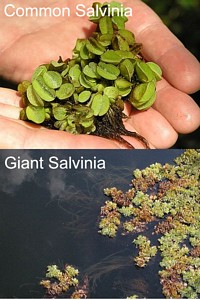
Giant salvinia (Salvinia molesta) is native to South America. It is a small free-floating plant that grows in clusters and develops into dense, floating mats or colonies in quiet water, undisturbed by wave action. The floating leaves of giant salvinia are oblong (0.5 (12mm) to 1.5 (35mm) inches long) with a distinct midrib along which the leaf may fold forming a compressed chain-like appearance. Giant salvinia has sporangia but are thought to reproduce only by fragmentation. Giant salvinia can double in size in 4 to 10 days under good conditions.
Dense salvinia colonies provide habitat for micro invertebrates but if salvinia completely covers the surface of a pond it will cause dissolved oxygen depletions and fish kills. These colonies will also eliminate submerged plants by blocking sunlight penetration. Salvinias have no known direct food value to wildlife and is considered an exotic and highly undesirable species.
Chemical
The active ingredient that has been successful in treating Salvinia is diquat.
A liquid diquat formulation has been effective on Salvinia. It is a contact algaecide and herbicide. Contact herbicides act quickly and kill all plants cells that they contact. A non-ionic aquatically registered surfactant (see the label) will have to be added to the product solution for good results.
Read more about Salvinia (new window)
Common Duckweed, Giant Duckweed
Common duckweed (Lemna minor) is a very small light green free-floating, seed bearing plant. Duckweed has 1 to 3 leaves, or fronds, of 1/16 to 1/8 inch in length. A single root (or root-hair) protrudes from each frond. Giant (Spirodela polyrhiza) or big duckweed is still relatively small (1/16 to 1/4 inch) with 1 to 4 leaves, or fronds, light green in color. Three or more roots (or root-hairs) protrude from each frond. Duckweeds tend to grow in dense colonies in quiet water, undisturbed by wave action. Often more than one species of duckweed will be associated together in these colonies and can be an aggressive invader of ponds and are often found mixed in with other duckweeds, mosquito fern, and/or watermeal. If colonies cover the surface of the water, then oxygen depletions and fish kills can occur. These plants should be controlled before they cover the entire surface of the pond.

Dense duckweed colonies provide habitat for micro invertebrates but if duckweed completely covers the surface of a pond for an extended period it will cause oxygen depletions. These colonies will also eliminate submerged plants by blocking sunlight penetration. Many kinds of ducks consume duckweed and often transport it to other bodies of water.
Control Options
Mechanical/Physical
Duckweeds can be removed by raking or seining it from the pond's surface.
Chemical
The active ingredients that have been successful in treating duckweeds include diquat, a liquid diquat formulation that has been effective on duckweeds. It is a contact algaecide and herbicide. Contact herbicides act quickly and kill all plants cells that they contact.
Read more about Duck weed (new window)
Water Lettuce
Non-Native
Water lettuce (Pistia stratiotes) is a free-floating plant with many spongy, dusty green simple leaves. The leaves are covered in very fine hairs and arranged in a spiral pattern from the center of the plant. The leaves are 1 to 6 inches wide and have large veins running their length. The flowers are seldom seen. Water lettuce is a very aggressive invader and can form thick floating mats. If these mats cover the entire surface of the pond they can cause oxygen depletions and fish kills. Water lettuce should be controlled so they do not cover the entire pond.
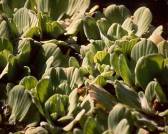
Control Options
Mechanical/Physical
Water lettuce can be removed by raking or seining it from the pond's surface.
Chemical
The active ingredient that has been successful in treating water hyacinth include diquat.
Read more about Water Lettuce (new window)
Water Hyacinth
Non-Native

Water hyacinth is native to South America but has naturalized much of the Southern U.S.Water hyacinth is a free-floating perennial plant that can grow to a height of 3 feet. The dark green leave blades are circular to elliptical in shape attached to a spongy, inflated petiole. Underneath the water is a thick, heavily branched, dark fibrous root system. The water hyacinth has striking light blue to violet flowers located on a terminal spike. Water hyacinth is a very aggressive invader and can form thick mats. If these mats cover the entire surface of the pond they can cause oxygen depletions and fish kills.
Water hyacinths should be controlled so they do not cover the entire pond.
Control Options
Mechanical/Physical
Water hyacinth can be removed by raking or seining it from the pond's surface.
Chemical
The active ingredients that have been successful in treating water hyacinth include diquat and glyphosate.
A liquid diquat formulation has been effective on water hyacinth. It is a contact algaecide and herbicide. Contact herbicides act quickly and kill all plants cells that they contact. A non-ionic aquatically registered surfactant (see the label) will have to be added to the product solution for good results.
Hydrogel is the carrier of the Herbicide Diquat it binds the diquat into a gel form when and when applied over the weed being treated it binds the herbicide onto the plant/weed reducing run-off giving a more effective result.
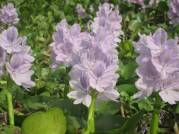
Country Glyphosate formulation has been effective on water hyacinth. These are broad spectrum, systemic herbicides. Systemic herbicides are absorbed and move within the plant to the site of action. Systemic herbicides tend to act more slowly than contact herbicides. An aquatically registered surfactant (see the label) will have to be added to the glyphosate solution for good results.
Information and photos courtesy of: Department of Wildlife and Fisheries Sciences, Texas A&M University http://aquaplant.tamu.edu/
Read more about Water Hyacinth (new window)
Coontail
Coontail (Ceratophyllum demersum), or sometimes called hornwort, is a dark olive-green, rootless submerged perennial plant that often forms dense colonies. Leaves are relatively stiff, whorled with many forks and small teeth along one edge. The tips of branches are crowded with leaves giving it a "Coontail" resemblance. Coontail reproduces by seeds and fragmentation.
Control Options
Mechanical/Physical
Coontail can be removed by raking or seining it from the pond but will re-establish from any remaining fragments. Fertilization to produce a phytoplankton or algal "bloom" prevents the establishment of most bottom rooted aquatic weeds and produces a strong food chain to the pond fish. Non-toxic dyes or colorants prevent or reduce aquatic plant growth by limiting sunlight penetration, similar to fertilization. However, dyes do not enhance the natural food chain and may suppress the natural food chain of the pond.
Chemical
The active ingredients that have been successful in treating Coontail include copper complexes (G), and diquat (E).

A liquid diquat formulation that has been effective on Coontail. It is a contact algaecide and herbicide. Contact herbicides act quickly and kill all plants cells that they contact.
Hydrogel is the carrier of the Herbicide Diquat it binds the diquat into a gel form when applied over the water surface it falls through the water column and attaches itself to the weed plant being treated Less herbicide is used and is more effective in treating large ponds and lakes.
Information and photos courtesy of: Department of Wildlife and Fisheries Sciences, Texas A&M University http://aquaplant.tamu.edu/
Read more about Coontail (new window)
Egeria
Non-Native
Egeria is native to South America but has become naturalized in much of the South eastern and South east Australia. Egeria is a rooted perennial plant but can survive and grow as floating fragments. The dark green lance-like leaves are in whorls of 4 to 6 which become more dense near the tip of the stem (near the surface). Leaves are about 1/2 (13mm)inch wide and from 3/4 (16mm) to 1 1/4 (30mm) inches long with finely toothed margins. Flowers are white about 3/8 to 3/4 (10mm-16mm)inches in diameter on short stalks which commonly are emergent.
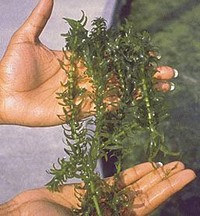
Egeria is often confused with the native Elodea or the non-native Hydrilla. Hydrilla has one or more teeth on the underside of the midrib, neither Elodea nor Egeria have these midrib teeth. The teeth make Hydrilla feel rough when drawn through your hand from base to tip. Flowers of Egeria are larger than Hydrilla. Egeria leaves are larger than elodea and in whorls of 4 to 6 and not 3 as with elodea.
Control Options
Mechanical/Physical
Egeria can be removed by raking or seining it from the pond but will re-establish from any remaining fragments and roots. Fertilization to produce a phytoplankton or algal "bloom" prevents the establishment of most bottom rooted aquatic weeds and produces a strong food chain to the pond fish. Non-toxic dyes or colorants prevent or reduce aquatic plant growth by limiting sunlight penetration, similar to fertilization. However, dyes do not enhance the natural food chain and may suppress the natural food chain of the pond.
Chemical
The active ingredients that have been successful in treating Egeria include copper complexes (G), diquat (G), copper with diquat (E).
A liquid diquat formulation that has been effective on elodea. It is a contact algaecide and herbicide. Contact herbicides act quickly and kill all plants cells that they contact.
Hydrogel is the carrier of the Herbicide Diquat it binds the diquat into a gel form when applied over the water surface it falls through the water column and attaches itself to the weed plant being treated Less herbicide is used and is more effective in treating large ponds and lakes.
Information and photos courtesy of: Department of Wildlife and Fisheries Sciences, Texas A&M University http://aquaplant.tamu.edu/
Read more about Egeria (new window)
Elodea
Elodea (Elodea canadensis) is a rooted multi-branched perennial plant but can survive and grow as floating fragments. The dark green blade-like leaves (3/5 (7mm) inch long and 1/5 (5mm) inch wide) are in whorls of three with finely toothed margins. The flowers of Elodea have three white petals with a waxy coating that makes them float.
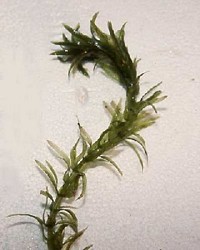
Submerged portions of all aquatic plants provide habitats for many micro and macro invertebrates. These invertebrates in turn are used as food by fish and other wildlife species (e.g. amphibians, reptiles, ducks, etc.). After aquatic plants die, their decomposition by bacteria and fungi provides food (called "detritus") for many aquatic invertebrates. Elodea has no known direct food value to wildlife but is used extensively by insects and invertebrates.
Elodea is often confused with Hydrilla and Egeria. Elodea has only 3 leaves in the whorl and no midrib teeth.
Control Options
Mechanical/Physical
Elodea can be removed by raking or seining it from the pond but will re-establish from any remaining fragments and roots. Fertilization to produce a phytoplankton or algal "bloom" prevents the establishment of most bottom rooted aquatic weeds and produces a strong food chain to the pond fish. Non-toxic dyes or colorants prevent or reduce aquatic plant growth by limiting sunlight penetration, similar to fertilization. However, dyes do not enhance the natural food chain and may suppress the natural food chain of the pond.
Chemical
The active ingredients that have been successful in treating elodea include diquat (E), E = excellent.
A liquid diquat formulation that has been effective on elodea. It is a contact algaecide and herbicide. Contact herbicides act quickly and kill all plants cells that they contact.
Hydrogel is the carrier of the Herbicide Diquat it binds the diquat into a gel form when applied over the water surface it falls through the water column and attaches itself to the weed plant being treated Less herbicide is used and is more effective in treating large ponds and lakes.
Information and photos courtesy of: Department of Wildlife and Fisheries Sciences, Texas A&M University http://aquaplant.tamu.edu/
Read more about Elodea (new window)
Fanwort
Fanwort (Cabomba caroliniana)is multi-branched submerged perennial plant except for a few small 1/2 (13mm)- 1 1/4 (30mm)inches long alternately arranged elongated floating leaves. The submerged leaves are opposite, attached by a single petiole, but above the petiole form a finely divided "fan-shaped" leaf. Fanwort has a small (1/2 (13mm) to 3/4 (30mm) inch diameter) white to pink flower which arises from the tip of the stem and stands slightly above the waters surface.
Control Options
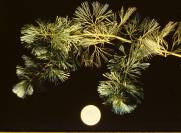
Mechanical/Physical
Fanwort can be removed by raking or seining it from the pond but will re-establish from any remaining roots. Fertilization to produce a phytoplankton or algal "bloom" prevents the establishment of most bottom rooted aquatic weeds and produces a strong food chain to the pond fish. Non-toxic dyes or colorants prevent or reduce aquatic plant growth by limiting sunlight penetration, similar to fertilization. However, dyes do not enhance the natural food chain and may suppress the natural food chain of the pond.
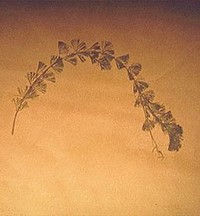
Chemical
There are no Chemical compounds that completely eradicate Cabomba several herbicides are being evaluated to determines effectiveness.
Information and photos courtesy of: Department of Wildlife and Fisheries Sciences, Texas A&M University http://aquaplant.tamu.edu/
Read more about Fanwort (new window)
Hydrilla
Hydrilla is a perennial plant that forms dense colonies and can grow to the surface in water over 20 feet deep. Hydrilla branches profusely and after reaching the surface it extends across it forming thick mats. Hydrilla can reproduce by fragmentation, from seeds, from turions (axillary buds), and from tubers. Leaves are blade-like about 1/8 inch (3mm) and 3/8(9mm) inch long with small tooth margins and spines on the underside of the midrib which make them feel rough. Leaves are usually 4 to 8 in a whorl.
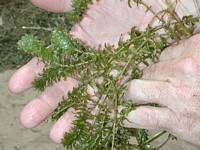
Hydrilla is native to Australia Europe and Asia and was probably taken to the U.S. for the aquarium industry. It is considered a noxious pest because it grows so rapidly, out competing and eliminating native species, and forming surface mats that hinder recreation, navigation, and water intakes.
Hydrilla is often confused with the native Elodea or the non-native Egeria. Hydrilla has one or more teeth on the underside of the midrib, neither Elodea nor Egeria have these midrib teeth. The teeth make Hydrilla feel rough when drawn through your hand from base to tip. Flowers of Hydrilla are much smaller (1/4 inch (6mm) in diameter) than Egeria.
Control Options
Mechanical/Physical
Hydrilla can be removed by raking or seining it from the pond but will re-establish from any remaining fragments, roots, tubers, and other vegetative structures. Fertilization to produce a phytoplankton or algal "bloom" prevents the establishment of most bottom rooted aquatic weeds and produces a strong food chain to the pond fish. Non-toxic dyes or colorants prevent or reduce aquatic plant growth by limiting sunlight penetration, similar to fertilization. However, dyes do not enhance the natural food chain and may suppress the natural food chain of the pond.
Chemical
The active ingredients that have been successful in treating Hydrilla include diquat (G), copper complexes (G), copper with diquat (E).
A liquid diquat formulation that has been effective on Hydrilla. It is a contact algaecide and herbicide. Contact herbicides act quickly and kill all plants cells that they contact.
Hydrogel is the carrier of the Herbicide Diquat it binds the diquat into a gel form when applied over the water surface it falls through the water column and attaches itself to the weed plant being treated Less herbicide is used and is more effective in treating large ponds and lakes.
Information and photos courtesy of: Department of Wildlife and Fisheries Sciences, Texas A&M University http://aquaplant.tamu.edu/
Read more about Hydrilla (new window)
Parrotfeather
Non-Native
Parrot feather (Myriophyllum aquaticum) is a native of South America and was probably brought to the U.S. for the aquarium industry. It is a rooted, submerged perennial plant that usually grows in shallow water. Parrot feather gets it name from the gray-green thickly bunched leaves that rise above the water. These exposed leaves are whorled and have frilly divisions that give it a feather-like appearance. Underwater leaves are similar but less dense. The stems are relatively stiff.
Control Options
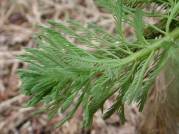
Mechanical/Physical
Parrot feather can be removed by raking or seining it from the pond but will re establish from any remaining fragments and roots. Fertilization to produce a phytoplankton or algal "bloom" prevents the establishment of most bottom rooted aquatic weeds and produces a strong food chain to the pond fish. Non-toxic dyes or colorants prevent or reduce aquatic plant growth by limiting sunlight penetration, similar to fertilization. However, dyes do not enhance the natural food chain and may suppress the natural food chain of the pond.
Chemical
The active ingredients that have been successful in treating parrot feather include diquat (G), copper with diquat (E).
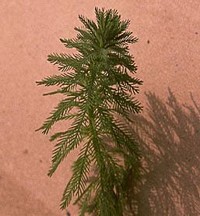
A liquid diquat formulation has been effective on parrot feather and is more effective if mixed with a copper compound. It is a contact herbicide. Contact herbicides act quickly and kill all plants cells that they contact.
Hydrogel is the carrier of the Herbicide Diquat it binds the diquat into a gel form when and when applied over the weed being treated it binds the herbicide onto the plant/weed reducing run-off giving a more effective result.
Information and photos courtesy of: Department of Wildlife and Fisheries Sciences, Texas A&M University http://aquaplant.tamu.edu/
Read more about Parrots Feather (new window)
Pondweeds
The Pondweed family consists of multiple species of plants including American Pondweed, Baby Pondweed Curly Leaf Pondweed, Illinois Pondweed, Sago Pondweed and Variable Leaf Pondweed.
American pondweed is a perennial plant that has both floating and a few submerged leaves in an alternate pattern. The floating leaves are elliptical to oval 4 (90mm) to 7 (220mm) inches long and to 2.5 (35mm) inches wide on long petioles. Submerged leaves are not abundant and are blade-like, somewhat transparent and smaller than floating leaves. Fruits are on spikes that often stand above the water’s surface and are brownish to reddish 3 (75mm)to 21(450mm) inches long and 1/8 (3mm) to1/4 (5mm) inches wide.
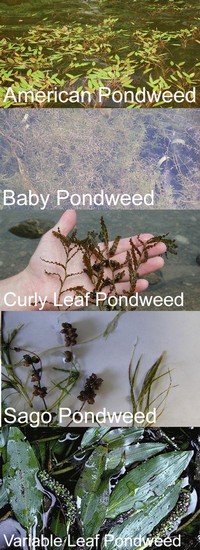
Baby pondweed is a perennial plant that arises from thickly matted rhizomes and has no floating leaves. The stems are thin, long and highly branching with leaves very thin and filament-like, about 1/16 (2mm) of an inch wide and 2 (48mm) to over 12 (300mm)inches long tapering to a point. The leaves grow in thick layers and originate from a sheath. The fruit is nut-like 1/8 (3mm) to ¼(5mm) inches long and 1/10 (2mm) to 1/8 inches (3mm) wide.
Curly-leafed pondweed is a perennial plant that is native to Europe and gets it name from the rippled or wavy nature of its submerged leaves. The leaves are alternate, oblong 3/4 (17mm) to 4 (90mm)inches long and ¼ (6mm) to 1/2 (2mm)inches wide. Mature leaves are toothed with a distinct midrib with paired parallel lateral veins, nearly translucent. Stems are flattened and branching. Fruits are seldom found, they reproduce from small "burr-like" vegetative structures that from a the base of some leaves. Curly-leafed pondweed can be an aggressive invader that can cover large portions of ponds.
Illinois pondweed is a perennial plant that has mostly submerged leaves, sometimes with a few floating leaves in an alternate pattern. The submerged leaves are blade-like 1 (24mm) to over 7(220mm) inches long and 1/2 (12mmm) to 2 1/2 (60mm) inches wide. The petiole is short on submerged leaves and less that the leaf in length. Floating leaves are often not present. Floating leaves are blade-like to elliptical 1(24mm) to 6 (150mm) inches long and 3 (75mm) to 2 (50mm) inches wide. Fruits are greenish 1/2 (12mm)to 3 (75mm)inches long and 1/8 (3mm)to1/4 (6mm) inches wide, located on the tip of stems and usually stick above the water surface.
Sago pondweed is a perennial plant that arises from thickly matted rhizomes and has no floating leaves. The stems are thin, long and highly branching with leaves very thin and filament-like, about 1/16 (2mm) of an inch wide and 2 (48mm) to over 12 (3000mm) inches long tapering to a point. The leaves grow in thick layers and originate from a sheath. The fruit is nut-like 1/8 (3mm) to 1/4 (6mm) inches long and 1/10(2mm)to 1/8 (2mm)inches wide.
Variable-leaf pondweed is a perennial plant that has two kinds of leaves. The floating leaves are leathery textured, oval to elliptical 3/8 (9mm)to 1 ½ (35mm) inches long and 3/8 (9mm) to 3/4 (18mm) inches wide with a petiole one to two times a long as the blade. The submerged leaves are thin, less than 1/8 (3mm) of an inch wide and 3/4 (18mm) to 2 1/4 (54mm) inches long with obvious mid vein and a pointed tip. The fruits are flat about 1/8(3mm)of an inch wide and arise from the axis of the floating leaves.
Control Options
Mechanical/Physical
Pondweed can be removed by raking or seining it from the pond but will reestablish from any remaining fragments and roots. Fertilization to produce a phytoplankton or algal "bloom" prevents the establishment of most bottom rooted aquatic weeds and produces a strong food chain to the pond fish. Non-toxic dyes or colorants prevent or reduce aquatic plant growth by limiting sunlight penetration, similar to fertilization. However, dyes do not enhance the natural food chain and may suppress the natural food chain of the pond.
Chemical
The active ingredients that have been successful in treating pondweeds include copper complexes (G), diquat (E), E = excellent, G = good.
A liquid diquat formulation that has been effective on pondweeds. It is a contact algaecide and herbicide. Contact herbicides act quickly and kill all plants cells that they contact.
Information and photos courtesy of: Department of Wildlife and Fisheries Sciences, Texas A&M University http://aquaplant.tamu.edu/
Read more about Pondweed (new window)![Hydrogel [Go to homepage]](style/sp.gif)